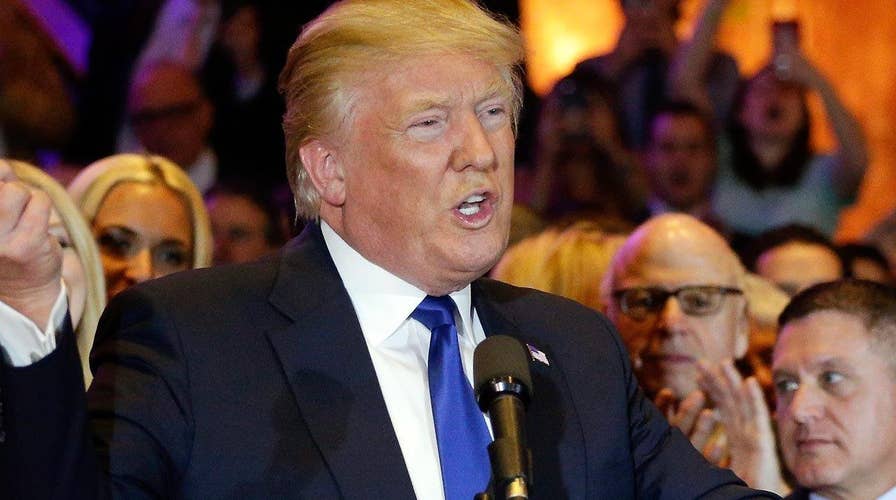Trump: We don't have much of a race anymore
Republican presidential frontrunner thanks supporters after victory in New York primary
There are two ways to analyze Donald Trump’s decisive win in New York’s presidential primary.
First, it’s the acknowledgment of a big run for Trump this week and next during which the GOP frontrunner will amass delegates at a faster clip than any of the other three Republicans in the race – in the process, stretching his lead over Texas Sen. Ted Cruz and pumping up the volume that the Republican nomination is deservedly The Donald’s regardless of where the delegate tally stands going into July’s national convention in Cleveland.
Trump’s argument will look good – on paper, at least.
After New York, he’s two-thirds of the way to the 1,237 delegates required by the GOP and a guaranteed first-ballot win in Cleveland.
If he’s smart, Trump will use the rest of April and May to keep driving home one word: “inevitability.”
For argument’s sake, let’s give Trump roughly 100 of the 172 delegates up for grabs next Tuesday (all the action occurring in his mid-Atlantic backyard of Connecticut, Delaware, Maryland, Pennsylvania and Rhode Island).
Once the five states holding GOP contests in May apportion their combined 199 delegates, Trump’s total should enter four-digit territory. Per this Associated Press breakdown, a first-ballot scenario remains feasible.
If he’s smart, Trump will use the rest of April and May to keep driving home one word: “inevitability”. Backed up by this exit poll data showing that an overwhelming number of New York Republicans saying the candidate with the most primary votes should be the party’s nominee.
Now, the other takeaway from New York: “the Sinatra question”.
To paraphrase that other “Chairman of the Board”, if Trump can make it there – winning big in the Empire State in a closed Republican primary – can he make it anywhere with three-fifths of a primary electorate that hasn’t bought into his candidacy?
The answer: no (not in every primary, at least) . . . and stay tuned.
May will not be the friendliest of months for Trump, what with a first-Tuesday primary in Indiana that could spell more Midwestern trouble (perhaps a repeat of his meltdown in Wisconsin).
After that: a winner-take-all contest in Nebraska that likely will go to Cruz (draw a line from Texas to North Dakota and it runs through states Cruz has won). Finally, Oregon and Washington awarding their delegates proportionally.
Not much of a buzz there.
However, there is an opportunity for Trump to take a major step forward – in a way having nothing to do with bean-counting and convention arcana. And that would be courting those skeptical Republicans still waiting for a Trumpian “pivot” from angry rhetoric and juvenile social-media insults to a more dignified tone and statesmanlike persona.
The news that broke on the same day as New York’s results – that Trump is shaking up his senior campaign staff and empowering his team to spend aggressively to win in May and June – is a first step in that direction.
The next step: breaching divides within the GOP.
According to the latest NBC News/Wall Street Journal poll, 63 percent of Republican primary voters say they could be satisfied with Trump as the GOP nominee.
The good news: it’s better than the 49 percent Trump received back in the March exit polls.
Not so good: it cries of work to be done – specifically, shoring up support among conservatives uneasy of Trump’s past policy inconsistencies and his unwilling in this campaign to take on entitlement spending and the federal budget dragon.
Four years ago, conservatives accounted for 35 percent of that year’s presidential turnout, the highest share since pollsters first began recording that statistic back in 1976; 82 percent of them voted for Mitt Romney. Four years previously, conservatives were 34 percent of the turnout; only 78 percent voted for John McCain.
In theory, Cruz has a chance of repeating those percentages, if not improving on them. Can Trump? Only if he starts speaking the language.
Such is the unusual nature of this Republican contest. In late April of 2012, after 43 Republican primaries and caucuses had voted, Romney had distanced himself from the field to the point where he could travel to New Hampshire and deliver this speech with an eye on the general election. Romney promised “a new campaign to unite every American who knows in their heart that we can do better . . . the beginning of the end of the disappointments of the Obama years and the start of a new and better chapter that we will write together.”
Trump’s not in that position at present – and he may not be until the final night of the Republican National Convention.
Then again, he’s not the only candidate going through hard times these days.
The same NBC/WSJ poll that gave Trump a historically awful 24 percent positive/65 percent negative approval rating and had Hillary Clinton weighing in at 32 percent positive/56 percent negative. Cruz recorded a 26 percent positive/49 percent negative: Kasich came in at 31 percent positive; 19 percent negative.
Vermont Sen. Bernie Sanders, the democratic socialist and Clinton’s chief tormentor these days, received grades of 45 percent positive/36 percent negative, suggesting that the American electorate is not only sour on the political class, but sorely in need of a week in Caracas for a reality check on how a socialist county fares under Bernie Vision.
Will Trump take advantage of May’s light pace to transition from temper tantrums to a style more tempered? It’s the practical thing to do. Especially when confronted with national poll numbers that, for now at least, are practically awful.

